HARRIS M803VTAC M-803 Vehicular Tactical Unit (VTAC) User Manual Installation Guide
Harris Corporation M-803 Vehicular Tactical Unit (VTAC) Installation Guide
HARRIS >
Contents
- 1. Operators Manual
- 2. Installation Guide
Installation Guide
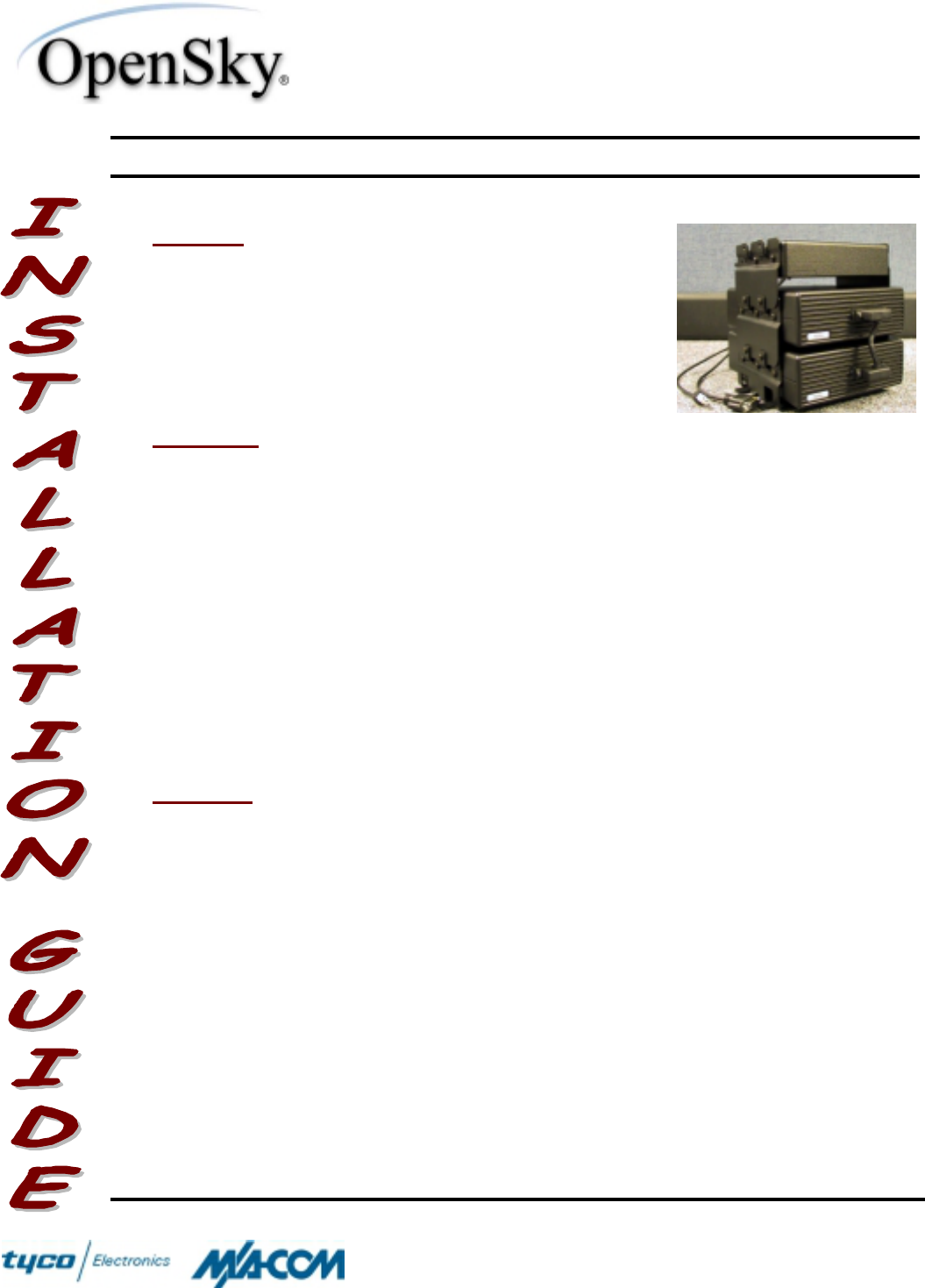
WINST-0009 Rev – WIRELESS SYSTEM BUSINESS UNIT
SUBJECT: M-803 VTAC Installation Instructions DATE: February 19, 2002
Page 1 of 19
COPYRIGHT ©2002 Printed in U.S.A.
M/A-COM
1011 Pawtucket Boulevard
Lowell, MA 01853
1-877-OPENSKY
(1-877-673-6759)
1-877-OPENSKY
OVERVIEW
This document describes the procedure for installing
the M/A-COM OpenSky® Model VR-803 Vehicular
Tactical Network (V-TAC) in a vehicle, such as an
automobile, truck, or van. This is a general guide only,
and assumes that the installation will be performed by
a professional radio installer.
DISCLAIMER
THE INSTALLATION INSTRUCTIONS PROVIDED IN THIS MANUAL ARE FOR
REFERENCE, AND DO NOT CREATE A WARRANTY OF ANY KIND AS TO THE
FUNCTIONALITY OF THE INSTALLED PRODUCT. THE ONLY WARRANTIES
THAT APPLY TO THIS PRODUCT ARE THOSE SET FORTH IN THE SALES
AGREEMENT.
M/A-COM INC. RECOMMENDS THAT BUYER USE ONLY A M/A-COM
AUTHORIZED REPRESENTATIVE TO INSTALL THIS PRODUCT.
THE WARRANTIES PROVIDED TO BUYER UNDER THE TERMS OF SALE
SHALL BE NULL AND VOID IF THIS PRODUCT IS INSTALLED OR SERVICED
IMPROPERLY, AND M/A-COM SHALL HAVE NO FURTHER OBLIGATION TO THE
BUYER FOR ANY DAMAGE CAUSED TO THE PRODUCT OR TO ANY PERSON
OR PERSONAL PROPERTY.
MAT ERIALS
There are three main components to the VR-803 V-TAC: the Full-Duplex Mobile
Radio Unit (MRU); the Vehicular Repeater Base Unit (VRB); and the RF Combiner.
The V-TAC is designed to mount on the floor or on a tray in the trunk or unoccupied
section of a vehicle. The V-TAC is designed to be operated with an externally-
mounted antenna. The Installation Kit (M/A-COM Part #MAMROS0019) needed to
install the V-TAC is described below. The V-TAC is intended to be used with a CH-
103 Control Head with Installation Kit, sold separately.
Table I lists the accessories that are included in the kit. Table II lists additional
options and accessories that may be purchased separately. (Note: The Installation
Kit does not include an antenna. An antenna must be purchased separately, and the
V-TAC may not be installed unless an antenna is to be installed at the same time.)

WINST-0009 Rev – WIRELESS SYSTEM BUSINESS UNIT
SUBJECT: M-803 VTAC Installation Instructions DATE: February 19, 2002
Page 2 of 19
COPYRIGHT ©2002 Printed in U.S.A.
M/A-COM
1011 Pawtucket Boulevard
Lowell, MA 01853
1-877-OPENSKY
(1-877-673-6759)
1-877-OPENSKY
IMPORTANT
Table I – Installation Kit Items
Item Qty Part Number Description
1 1 MAMROS0044 Base Bracket Kit
2 2 MAMROS0046 Extension Bracket Kit
3 1 MAMROS0068-0003 Fuse Kit, 3A
4 2 MAMROS0068-0015 Fuse Kit, 15A
5 3 MAMROS0051 DC Power Cable, M-803 (20 ft)
6 1 MAMROS0052 Multi-Cable Assembly
7 1 MAMROS0054 V-TAC Control Interface Assembly
8 1 MAMROS0078-TMB12 RF Cable, TNC to Mini-UHF, Blue
9 1 MAMROS0078-TMG12 RF Cable, TNC to Mini-UHF, Green
10 1 MAMROS0078-TTR12 RF Cable, TNC to TNC, Red
11 1 MAMROS0078-TTX12 RF Cable, TNC to TNC, Yellow
12 1 MAMROS0066 CAN Terminator, 3-Pin
13 1 MAMROS0060 Antenna Connector, TNC
Table II - Additional V-TAC Options and Accessories
Part Number Description
(TBD) GPS Upgrade Option
MAMROS0023 GPS Antenna Kit, Show/No-Show/Magnet Mount
MAMROS0033 Antenna Kit, Unity Gain, Rooftop
MAMROS0031 Antenna Kit, 3dB, Rooftop
MAMROS0024 Antenna Kit, Elevated 3dB, Trunk Mount
MAMROS0039 SMR/GPS Antenna Kit, 3dB, Rooftop
MAMROS0026 SMR/GPS Antenna Kit, Elevated 3dB, Trunk Mount
MAMROS0042 SMR/GPS Antenna Kit, Elevated 3dB, Mirror Mount
MAMROS0055 RS-232 Serial Computer Cable (6 ft)
INSTRUCTIONS
Upon removing all items from the box and verifying that all have been included,
proceed with the following steps to install the VR-803 V-TAC. Refer to Figure 1 for
location of connectors on the V-TAC.
Mounting of the V-TAC and Antenna in ways other than those
described below may adversely affect performance, violate FCC
rules on RF Exposure, and even damage the V-TAC.
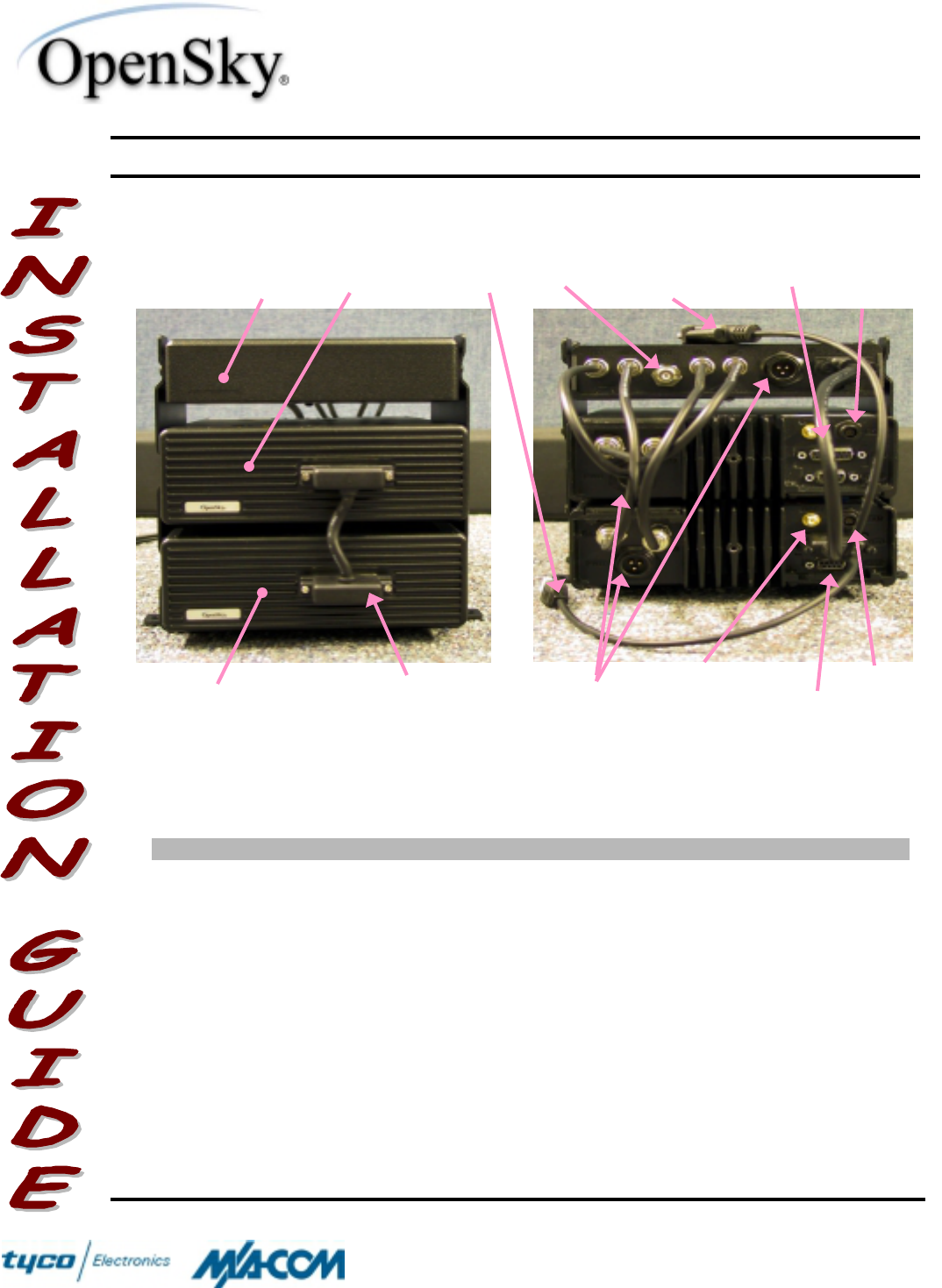
WINST-0009 Rev – WIRELESS SYSTEM BUSINESS UNIT
SUBJECT: M-803 VTAC Installation Instructions DATE: February 19, 2002
Page 3 of 19
COPYRIGHT ©2002 Printed in U.S.A.
M/A-COM
1011 Pawtucket Boulevard
Lowell, MA 01853
1-877-OPENSKY
(1-877-673-6759)
1-877-OPENSKY
Actions Notes
1. Plan the mounting locations of all
components (V-TAC, Antenna, and
Cables) and determine the routes for
all wiring and cables.
♦ Determine the customer’s preferences, if
any, for location of components. Comply with
these preferences insofar as they are
consistent with safety, manufacturer
specifications, and generally accepted
professional practices.
♦ Make certain that drilling holes or inserting
screws will not damage or interfere with any
existing vehicle components or wiring.
♦ Follow all manufacturer requirements and
guidelines for the location of components.
MRU
VRB
RF
Combiner
V-TAC Control
Interface Assembly
Multi-Cable
Assembly
D.C. Power
Connections RS-232
Serial Port
(SMA - Optional)
GPS Antenna CAN Port
Speaker
Connection
(Disabled)
GPS Data
Connection
(Optional) CAN Port
(Terminated)
Antenna
Port
(TNC)
Figure 1 - Front and Rear Views of VR-803 V-TAC
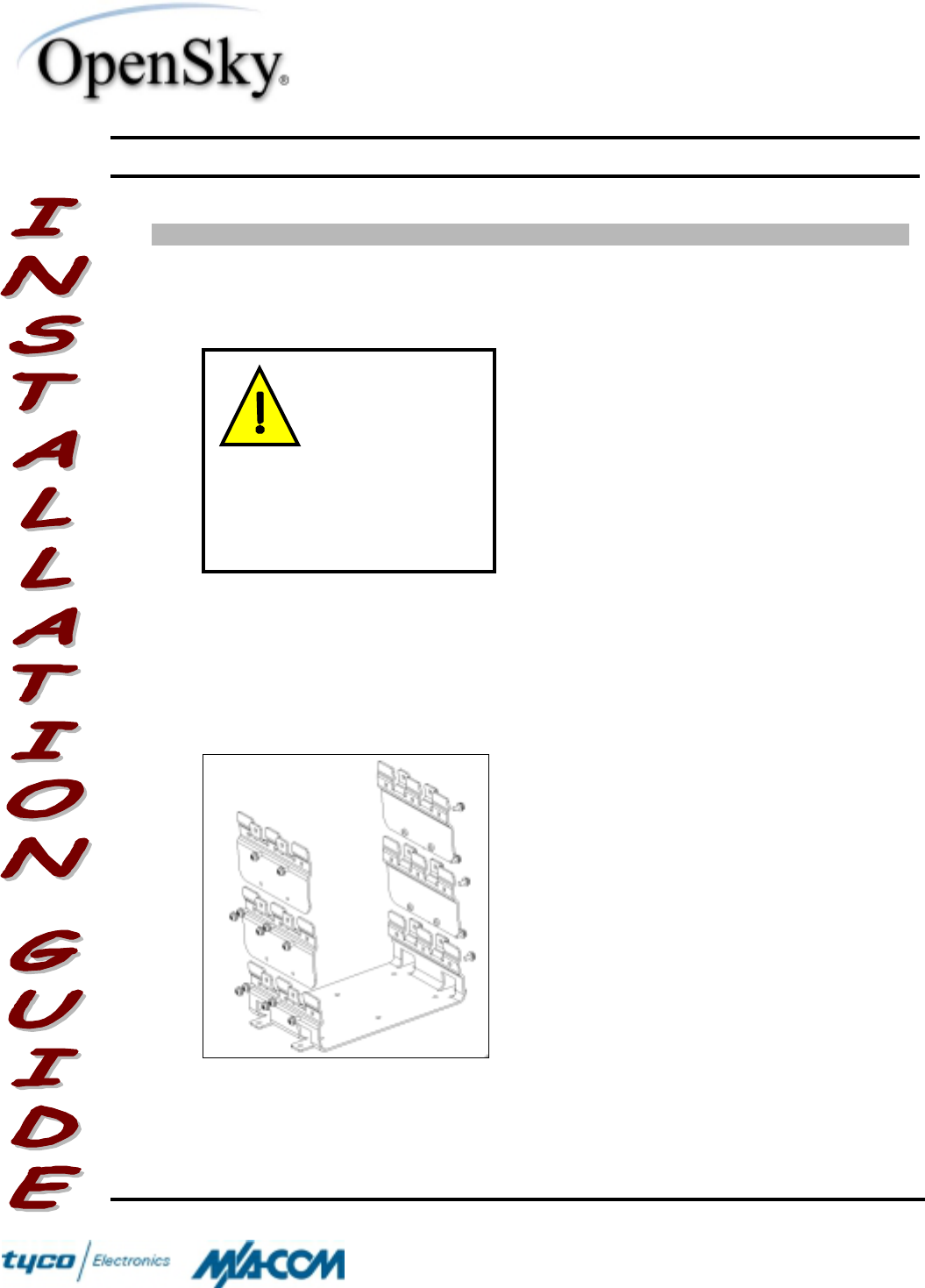
WINST-0009 Rev – WIRELESS SYSTEM BUSINESS UNIT
SUBJECT: M-803 VTAC Installation Instructions DATE: February 19, 2002
Page 4 of 19
COPYRIGHT ©2002 Printed in U.S.A.
M/A-COM
1011 Pawtucket Boulevard
Lowell, MA 01853
1-877-OPENSKY
(1-877-673-6759)
1-877-OPENSKY
Actions Notes
2. Mount the bracket in the interior of the
vehicle. ♦ As an assembled unit, the V-TAC weighs
over 20 lbs. It is unadvisable for the V-TAC
to be hung from a surface; rather, the V-TAC
is best mounted onto a firm, flat surface.
♦ Mount the Base Bracket from the Base
Bracket Kit (Item 1) on top of the floor of the
trunk according to the available space in the
vehicle or on the surface of a trunk tray.
♦ Screws for mounting the bracket are not
included, as all installations are different, but
at least 6 screws are required. Steel #10
screws are recommended.
♦ Screws for mounting the MRU into the Base
Bracket are included.
♦ The Bracket must be firmly held to the
surface in order to prevent unreasonable
vibration from damaging the V-TAC or
connections from loosening.
3. Create a support bracket by installing
the Extension Brackets onto the Base
Bracket.
♦ Install two Extension Brackets from the
Extension Bracket Kit (Item 2), one on either
side, onto the Base Bracket using 2 screws
from the kit. Tighten with a screwdriver until
the Extension Bracket is firm and flush to the
Base Bracket.
♦ The Extension Bracket can only be installed
onto the Base Bracket one way. See the
exploded view on the left for proper
alignment.
♦ Install the other two Extension Brackets, one
on either side, onto the Extension Brackets
just assembled.
♦ The Extension Bracket can only be installed
onto another Extension Bracket one way.
See the exploded view on the left for proper
alignment.
♦ Tighten with a screwdriver until the Extension
Bracket is firm and flush.
4. Mount the individual components into
the support bracket. ♦ It is easy to mistake the VRB for the MRU,
because they are manufactured into the
same chassis. There are two features,
The VR-803 V-TAC
must be kept away
from sources of heat.
Adequate ventilation
must be provided to
the rear fins of the
MRU and VRB. The V-TAC
reduces its RF output power
when its ambient temperature
exceeds +60ºC.
WARNING

WINST-0009 Rev – WIRELESS SYSTEM BUSINESS UNIT
SUBJECT: M-803 VTAC Installation Instructions DATE: February 19, 2002
Page 5 of 19
COPYRIGHT ©2002 Printed in U.S.A.
M/A-COM
1011 Pawtucket Boulevard
Lowell, MA 01853
1-877-OPENSKY
(1-877-673-6759)
1-877-OPENSKY
Actions Notes
however, to distinguish the two units:
! Each unit has a different product label.
! The MRU has a red and green color-
coding for the antenna ports, while the
VRB has a yellow and blue color-coding.
! See the picture on the left for locations of
the labels.
♦ Install the MRU into the lowermost bracket
spot using 6 screws (Item 10), 3 per side,
and tighten with a screwdriver until the
bracket is firm and flush to the surface of the
MRU.
♦ Install the VRB into the middle bracket spot
using 6 screws (Item 10), 3 per side. Do not
tighten these screws until the VTAC
Control Interface Assembly is installed (Step
7).
♦ Install the RF Combiner into the uppermost
bracket slot using 4 screws (Item 10), 2 per
side, and tighten with a screwdriver until the
bracket is firm and flush.
5. The CAN Port needs to be terminated
properly. ♦ Install the CAN Terminator (Item 12) onto the
smaller 3-pin connector at the rear of the
VRB by aligning the connector appropriately,
pushing, and twisting the outer housing
clockwise until it stops.
♦ The CAN Port of the MRU is where the CAN
Cable of the CH-103 Control Head is to be
connected. See the Installation Guide for the
CH-103 for more details.
6. The control connection between the
MRU and RF Combiner needs to be
made.
♦ Install the male15-pin, 2-row connector of the
Multi-Cable Assembly (Item 6) onto the
female mate at the rear of the MRU.
! Secure the connection by screwing the
jackscrews until they are firmly in place.
Do not over-tighten.
♦ Install the male15-pin, 3-row connector of the
Multi-Cable Assembly onto the female mate
at the rear of the RF Combiner.
NOTE Optimal perform-
ance of the Radio is based upon
proper mounting techniques. An
improperly mounted V-TAC may
experience degradation in the
quality of communication with
the OpenSky® network.
NOTE The Control Head
must be installed and connected
to the MRU before power to the
V-TAC is applied.
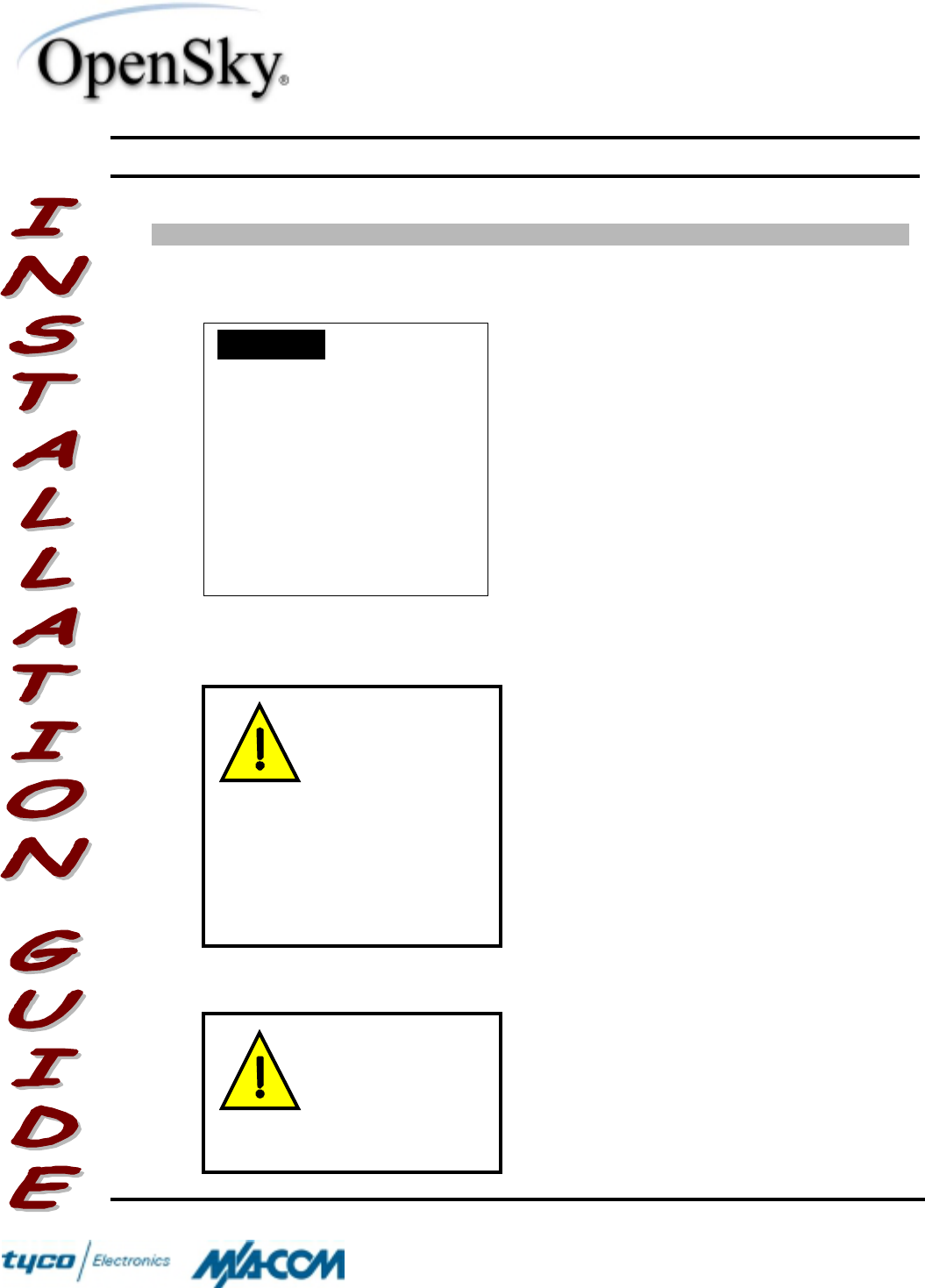
WINST-0009 Rev – WIRELESS SYSTEM BUSINESS UNIT
SUBJECT: M-803 VTAC Installation Instructions DATE: February 19, 2002
Page 6 of 19
COPYRIGHT ©2002 Printed in U.S.A.
M/A-COM
1011 Pawtucket Boulevard
Lowell, MA 01853
1-877-OPENSKY
(1-877-673-6759)
1-877-OPENSKY
Actions Notes
! Secure the connection by screwing the
jackscrews until they are firmly in place.
Do not over-tighten.
♦ The Multi-Cable Assembly supports an
interface for optional GPS in the V-TAC. The
9-pin female connection in the Multi-Cable
Assembly can be connected through an RS-
232 Serial cable to a COM Port of a
computer to access the GPS’s NMEA output.
! To connect this interface, mate the male
9-pin connector of the optional serial cable
to the female connector of the Multi-Cable
Assembly and tighten the jackscrews until
firm.
! Industry software to process GPS
information through this interface is not
supported by M/A-COM.
7. The control connection between the
MRU and VRB needs to be made. ♦ Install the V-TAC Control Interface Assembly
(Item 7) onto the connectors on the front
panels of the MRU and VRB.
! Screw the four screws of the Interface
Assembly with a screwdriver until they
stop. Do not over-tighten.
! The mounting screws of the VRB were
left loose in order to accommodate
proper alignment of the Interface
Assembly.
! Tighten the 6 mounting screws of the
VRB with a screwdriver until the bracket
is firm and flush to the surface of the
VRB.
8. The RF connections among all three
units must be made. ♦ The RF Cables are color-coded for proper
assembly. Assemble them as follows:
! Connect the Mini-UHF end of the blue-
coded RF Cable (Item 8) to the Mini-
UHF connector on the VRB, and
connect the TNC end to the blue-coded
connector on the RF Combiner.
! Connect the Mini-UHF end of the green-
coded RF Cable (Item 9) to the Mini-
NOTE The Multi-Cable
Assembly (Item 6) supports
multiple configurations of the M-
803 Radio Product Family. For
the V-TAC configuration, the 2-
pin speaker connection must be
left unconnected. Instead, the
speaker connection must come
from the CH-103 Control Head.
The speaker output from the
Multi-Cable Assembly is
disabled in the V-TAC.
Early versions of this
assembly have been
constructed with a
cable joining the two
multi-pin connectors
(shown in Figure 1).
For this type of assembly, slight
squeezing pressure must be
applied between the connectors to
reduce the strain when installed
and to ensure the screws do not
cross-thread.
WARNING
Improper installation
of the RF Cables may
lead not only to poor
radio performance,
but also to harmful
exposure. See
Antenna Mounting Configurations.
WARNING
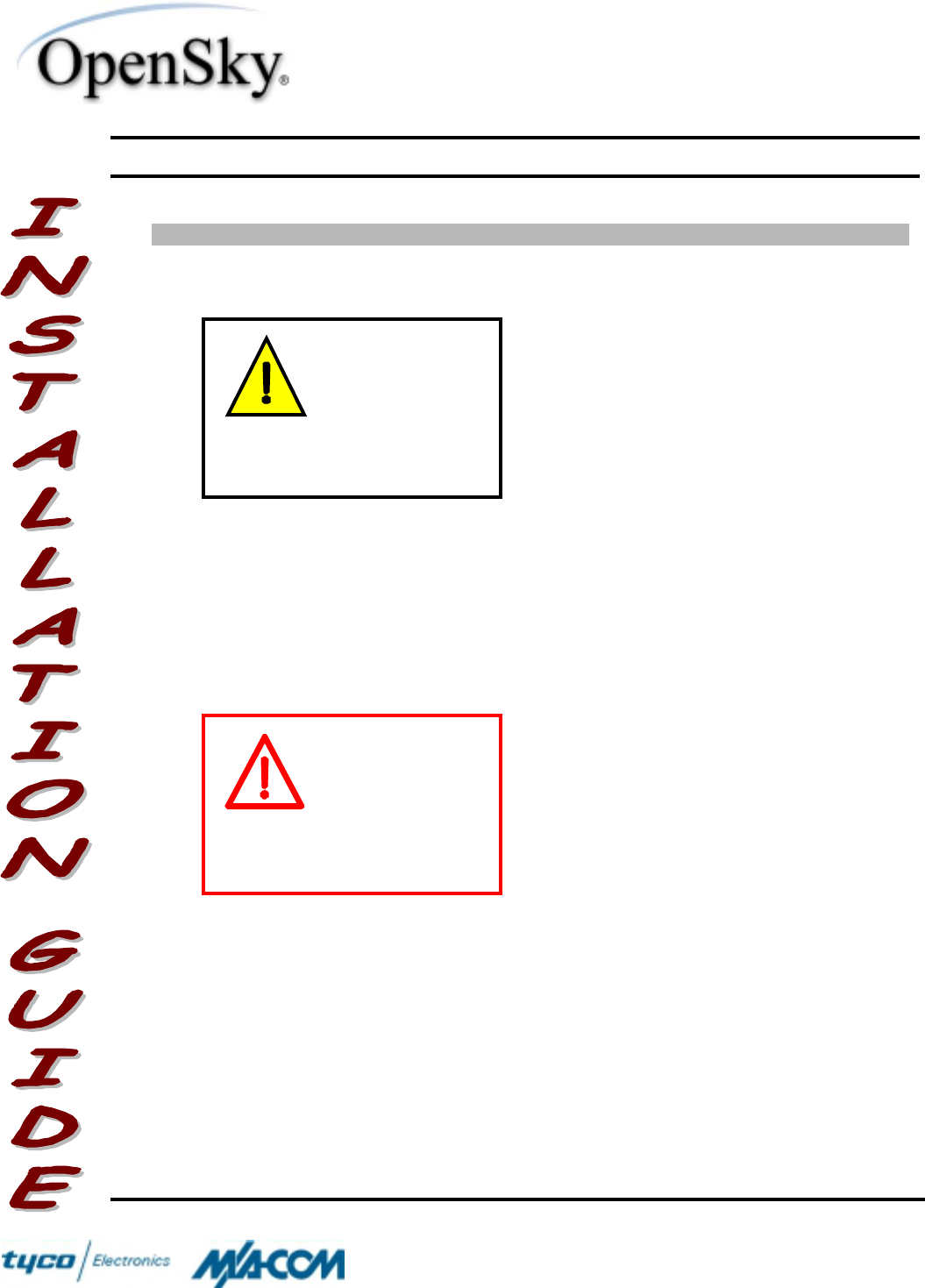
WINST-0009 Rev – WIRELESS SYSTEM BUSINESS UNIT
SUBJECT: M-803 VTAC Installation Instructions DATE: February 19, 2002
Page 7 of 19
COPYRIGHT ©2002 Printed in U.S.A.
M/A-COM
1011 Pawtucket Boulevard
Lowell, MA 01853
1-877-OPENSKY
(1-877-673-6759)
1-877-OPENSKY
Actions Notes UHF connector on the MRU, and
connect the TNC end to the green-
coded connector on the RF Combiner.
! Connect one of the TNC ends of the red-
coded RF Cable (Item 10) to the TNC
connector on the MRU, and connect the
other end to the red-coded connector on
the RF Combiner.
! Connect one of the TNC ends of the
yellow-coded RF Cable (Item 11) to the
TNC connector on the VRB, and
connect the other end to the yellow-
coded connector on the RF Combiner.
! Use a pair of pliers to snug the
connections. Do not over-tighten.
9. Mount the Antenna at a suitable
location on the vehicle, and route the
Antenna Cable inside the vehicle for
connection to the Radio.
♦ The Antenna is not included in the kit, as
several types of antennas can be used with
the V-TAC.
♦ The Antenna must be installed before
completion of the V-TAC installation.
♦ The optimal type of antenna to use is the
rooftop mount. For best performance, the
rooftop mount should be placed in the direct
center of the roof of the vehicle.
♦ Various mounting configurations are offered
for antennas available through M/A-COM.
Check with OpenSky® Customer Service for
more information.
♦ Refer to
Antenna Mounting Configurations
for requirements necessary to follow when
selecting the proper mounting area for the
antenna. Also, refer to the antenna
manufacturer’s mounting and testing
instructions included in the Antenna
Assembly kit for installation guidance once
the mounting area is determined.
♦ Route the cable from the Antenna to the rear
of the V-TAC out of the way of casual
contact.
♦ A Mini-UHF connector is generally included
with the Antenna Kit, but connection to the V-
Do not permanently
connect the antenna
to the V-TAC until
satisfactory testing
into a dummy load is
completed. Refer to
Testing into a Dummy Load for
further information.
IMPORTANT
To prevent RF
leakage and ensure
peak performance,
make sure that the
TNC and Mini-UHF
connectors are tight,
but not too tight that damage
occurs.
WARNING
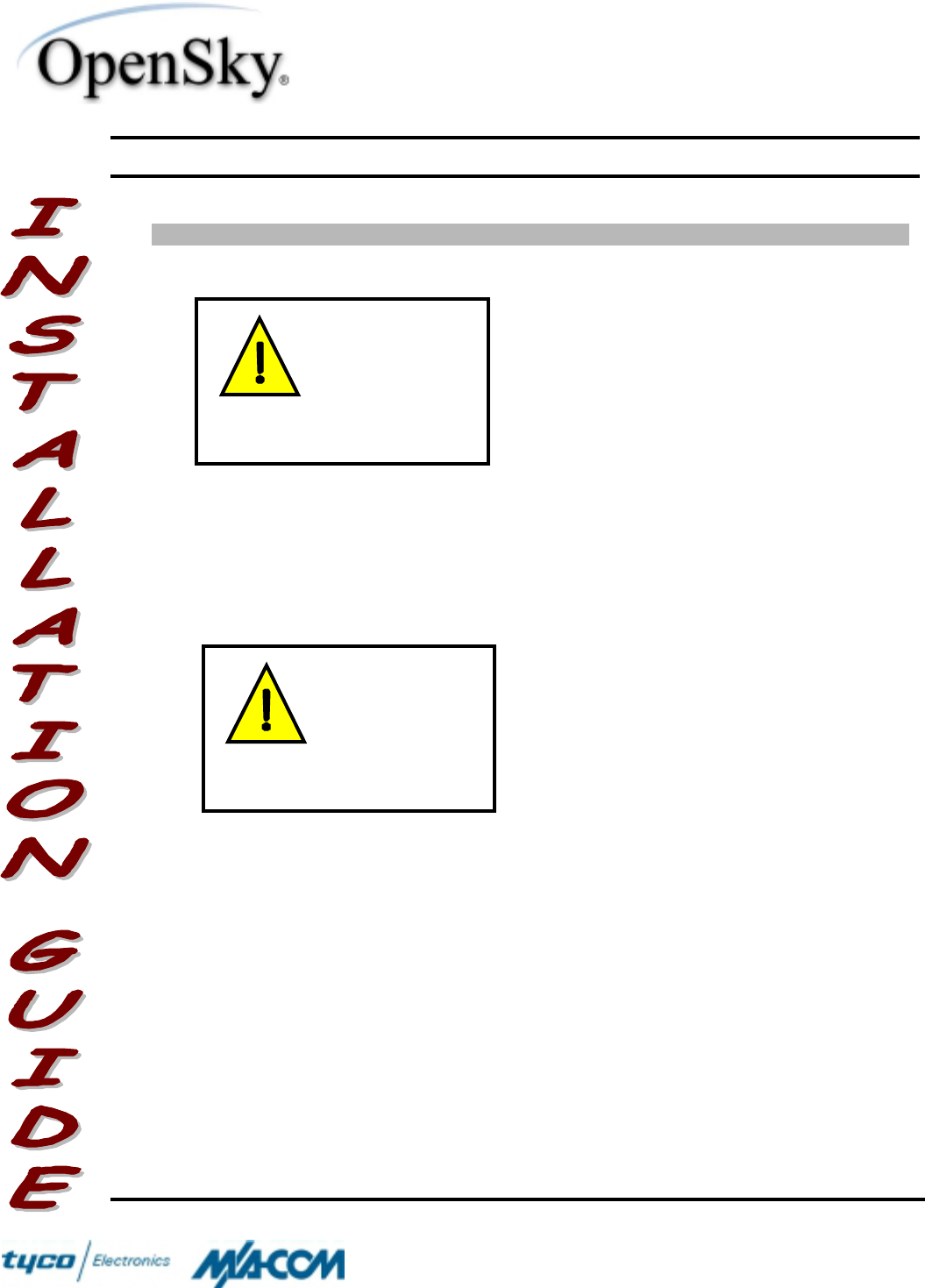
WINST-0009 Rev – WIRELESS SYSTEM BUSINESS UNIT
SUBJECT: M-803 VTAC Installation Instructions DATE: February 19, 2002
Page 8 of 19
COPYRIGHT ©2002 Printed in U.S.A.
M/A-COM
1011 Pawtucket Boulevard
Lowell, MA 01853
1-877-OPENSKY
(1-877-673-6759)
1-877-OPENSKY
Actions Notes
TAC must be TNC. Therefore, included in the
Installation Kit is a TNC Connector (Item 13).
♦ Crimp the TNC Connector onto the Antenna
cable by following the directions included in
the Antenna Kit.
♦ Screw the TNC Connector of the Antenna
Cable to the TNC Antenna Port connection
(coded with the color white) of the RF
Combiner, tightening until finger-tight.
♦ This will be a temporary connection until the
V-TAC and Antenna can be tested after the
V-TAC installation is complete. The antenna
needs to be connected in case of accidental
tranmission of the V-TAC occurs.
10. If an optional GPS unit is included in
the V-TAC, the GPS Antenna needs
to be connected.
♦ Screw the SMA plug of the GPS Antenna
cable to the SMA receptacle on the rear of
the MRU, tightening until finger-tight.
♦ Route the remaining cable out of the way of
casual contact.
♦ Various mounting configurations are offered
for GPS antennas available through M/A-
COM. Check with OpenSky® Customer
Service for more information.
♦ The GPS Antenna must be kept at least 6
inches from any other antenna mounted on
the vehicle and have at least 6 inches of
ground plane beneath it.
11. Prepare for connecting the power to
the V-TAC through the vehicle’s
firewall.
♦ Plan the cable route carefully, using an
existing access hole through the engine
firewall if possible. Alternatively, drill a new
hole approximately 3/8" in diameter and
install a rubber grommet to protect the cable.
12. The Fuses for the individual units in
the V-TAC must be installed in-line
with raw battery voltage.
♦ Strip one end of the wire included in the 3A
Fuse Kit (Item 3) and crimp a terminal lug
(not included) onto it which will mount directly
to the positive battery post.
♦ Cut the wire to a length of about 6 inches
and strip the end to a length indicated by the
gauge on the fuse holder.
To prevent RF
leakage and ensure
peak performance,
make sure that the
TNC connector is
tight, but not too
tight that damage occurs.
WARNING
To prevent RF
leakage and ensure
peak performance,
make sure that the
SMA connector is
tight, but not too
tight that damage occurs.
WARNING
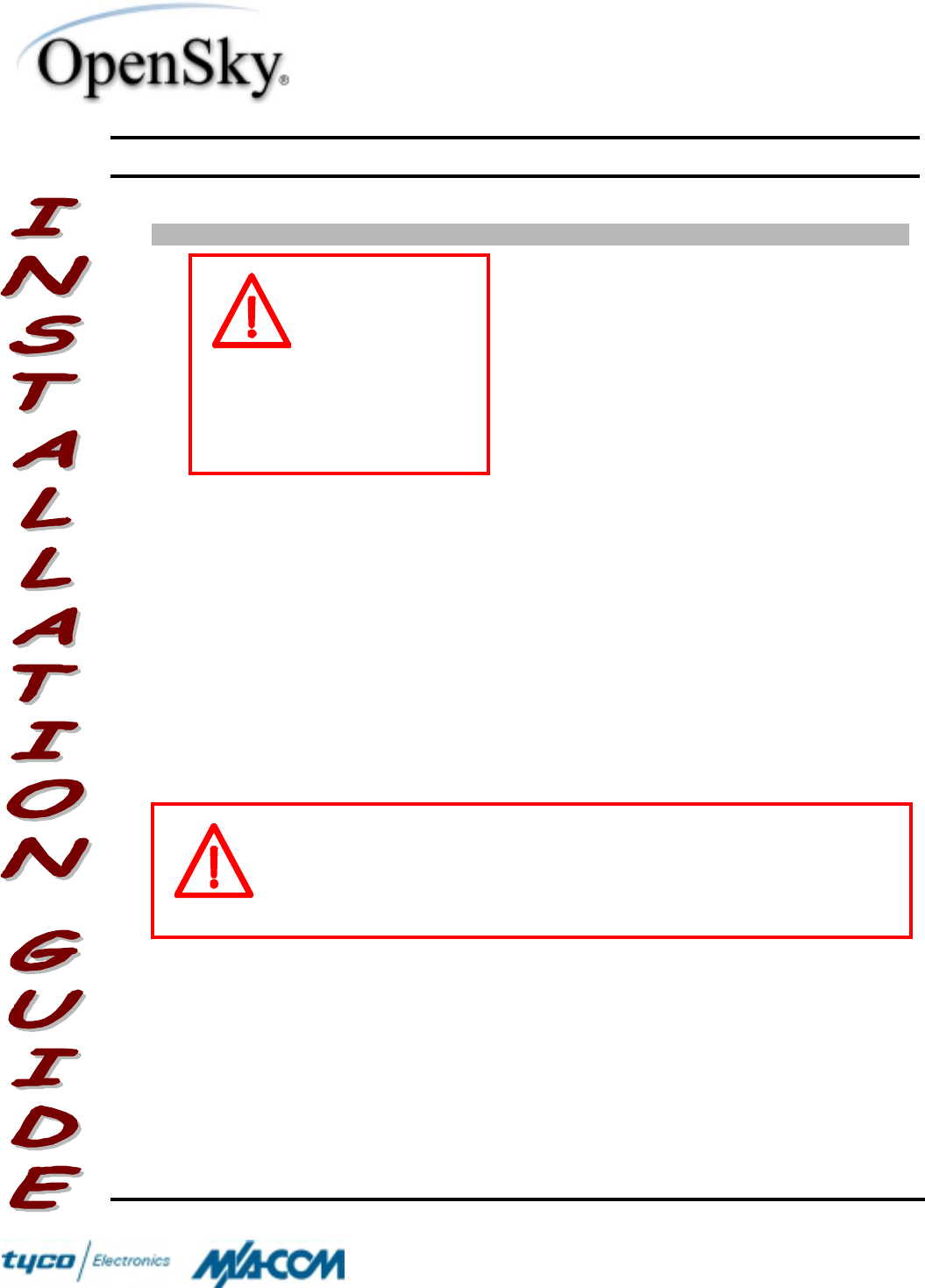
WINST-0009 Rev – WIRELESS SYSTEM BUSINESS UNIT
SUBJECT: M-803 VTAC Installation Instructions DATE: February 19, 2002
Page 9 of 19
COPYRIGHT ©2002 Printed in U.S.A.
M/A-COM
1011 Pawtucket Boulevard
Lowell, MA 01853
1-877-OPENSKY
(1-877-673-6759)
1-877-OPENSKY
Actions Notes
♦ Open the fuse holder and remove the fuse.
♦ Insert the stripped wire into the fuse holder
and push out the holder socket.
♦ Crimp the socket onto the wire at the crimp
end and pull the wire so that the socket seats
back into the holder.
♦ Use heat-shrink tubing to protect the
connection from foreign materials.
♦ Connect the remaining wire in a similar
fashion to the other end of the fuse holder.
♦ Connect the terminal to the vehicle’s battery
in the engine compartment.
♦ Mark or label the wire to indicate that the in-
line fuse is 3 Amps.
♦ Route the wire at the other end through a
wire loom and pass it through the firewall,
using a grommet to ensure that the wire is
not damaged.
♦ Repeat the procedure above for the two 15A
fuse kits (Item 4). Mark or label these wires
to indicate the in-line fuses are 15 Amps.
The Fuse must not
be installed in the
Fuse Holder until all
wiring is complete.
This will prevent the
V-TAC from
powering up prematurely and
causing an in-rush of current that
could lead to shorting of the
battery, sparking, or even fire.
IMPORTANT
Labeling of the fuse wires is important so that proper connection of the
three units of the V-TAC is obtained. The RF Combiner uses less
current than the MRU and VRB and is therefore rated at a lower
current. Connecting either the VRB or MRU to the 3A fuse will result in
an over-current event and cause the V-TAC to fail.
IMPORTANT

WINST-0009 Rev – WIRELESS SYSTEM BUSINESS UNIT
SUBJECT: M-803 VTAC Installation Instructions DATE: February 19, 2002
Page 10 of 19
COPYRIGHT ©2002 Printed in U.S.A.
M/A-COM
1011 Pawtucket Boulevard
Lowell, MA 01853
1-877-OPENSKY
(1-877-673-6759)
1-877-OPENSKY
Actions Notes
13. Connect the DC Power Cables and
prepare the ground connections prior
to applying power to the V-TAC.
♦ Connect one of the DC Power Cables (Item
5) to the 3-pin power connector at the rear of
the MRU.
♦ Connect a second DC Power Cable (Item 5)
to the 3-pin power connector at the rear of
the VRB.
♦ Connect the third DC Power Cable (Item 5)
to the 3-pin power connector at the rear of
the RF Combiner.
♦ Mark or label each DC Power Cable on both
ends with the name of the unit it is connected
to.
♦ Locate a chassis ground close to the V-TAC
and strip away any paint or dirt to expose
raw metal. The location of this connection
should be as close to the V-TAC that the
installation will allow.
♦ Cut the negative (black) wire as short as
possible on each DC Power Cable, strip
them, and crimp terminal lugs to them.
♦ Drill an appropriately sized hole for the
terminal into the cleared-out chassis location
and de-burr the hole.
♦ Screw all three lugs into the chassis ground.
Separate each lug with star washers and
ensure a reliable metal-to-metal contact.
NOTE The white wire of
the DC Power Cable is connected
to fused ignition sense of the
vehicle only in the Dash-Mount M-
803 Radio. It is not necessary to
connect the white wires of the three
DC Power Cables of the V-TAC to
ignition sense. The Control Head
wakes up the V-TAC when power
is applied. However, connection of
the ignition sense for the V-TAC
may be needed in the future in
configurations that do not use the
Control Head (e.g., data-only
applications). It is recommended
that the white wire be coiled and
placed aside rather than cut from
the cable assembly.

WINST-0009 Rev – WIRELESS SYSTEM BUSINESS UNIT
SUBJECT: M-803 VTAC Installation Instructions DATE: February 19, 2002
Page 11 of 19
COPYRIGHT ©2002 Printed in U.S.A.
M/A-COM
1011 Pawtucket Boulevard
Lowell, MA 01853
1-877-OPENSKY
(1-877-673-6759)
1-877-OPENSKY
Actions Notes
14. Apply the DC power connection to the
Radio. ♦ Route the positive (red) wires of all three DC
Power Cables through the vehicle, following
standard routing practices.
♦ Cut the wires to the proper lengths to be able
to connect to the Fuse Wires, which have
been routed through the firewall. Make sure
that the labeling of the wires is
maintained before cutting.
♦ Using a pigtail, butt-splice, or solder-sleeve,
connect the red wire from the DC Power
Cable of the RF Combiner to the 3A Fuse
Wire (Item 3).
♦ Using a pigtail, butt-splice, or solder-sleeve,
connect the red wire from the DC Power
Cable of the MRU to one of the 15A Fuse
Wires (Item 4).
♦ Using a pigtail, butt-splice, or solder-sleeve,
connect the red wire from the DC Power
Cable of the VRB to the other 15A Fuse
Wires (Item 4).
♦ Route the excess wire out of the way of
casual contact.
♦ Re-install the 3A fuse into the holder of the
3A Fuse Wire and ensure a tight connection.
♦ Re-install the 15A fuses into the holders of
the 15A Fuse Wires and ensure tight
connection.
♦ Verify that power is applied to the V-TAC by
checking the display on the Control Head. If
the display is not lit, press the on/off button
for 2 seconds until an asterisk appears on
the display and the display turns on.
15. Verify that the output of the V-TAC
into a dummy load meets
specifications.
♦ Refer to
Testing into a Dummy Load under
Testing below for the procedure.
16. Re-connect the Antenna and test the
forward and reflected power of the V-
TAC to verify transmission
performance.
♦ Refer to
Testing with the Antenna under
Testing below for the procedure.
NOTE Unlike many mobile
radios, the OpenSky® M-803
Radio Products power up
immediately upon application of
DC power to the state of last
control.

WINST-0009 Rev – WIRELESS SYSTEM BUSINESS UNIT
SUBJECT: M-803 VTAC Installation Instructions DATE: February 19, 2002
Page 12 of 19
COPYRIGHT ©2002 Printed in U.S.A.
M/A-COM
1011 Pawtucket Boulevard
Lowell, MA 01853
1-877-OPENSKY
(1-877-673-6759)
1-877-OPENSKY
Actions Notes
17. Complete the installation by
organizing, securing, and checking all
cables and components.
♦ Take whatever steps are practical to make
the installation neat and functional for the
Radio’s user. Organize and secure all
cables; make sure all connections are tight
but not over-stressed.
TESTING
This section sets forth procedures to verify the performance of the installed V-TAC.
Testing uses a wattmeter (or, alternatively, a VSWR meter) to measure RF power.
There are three procedures in this section: Changing Operating Modes, Testing into
a Dummy Load, and Testing with the Antenna. Note that, while the normal
operating mode of the V-TAC for voice or data communications is OpenSky® Trunking
Protocol (OTP), the radio must be operating in OpenSky® Conventional FM (OCF)
mode for testing. The reason for this is that OTP uses a Time Domain-Multiple Access
(TDMA) protocol in which transmit power is difficult to measure with standard
equipment. Conventional FM mode allows for 100% duty-cycle transmissions. Follow
the procedure under Changing Operating Modes to switch between the OCF and
OTP.
Note also that the accuracy of test results depends on a radio power source in the
range of 13.8–16 volts DC at greater than 8 amps. Make sure the vehicle’s battery is
fully charged by running the engine for a few minutes before the test, and keep the
engine running during the test procedures.
Test Equipment Comments
Wattmeter Bird Electronic Corporation Model 43 or
equivalent, with N-Series female connectors on
both the input and output sides.
As an alternative to using a wattmeter, a
Voltage Standing Wave Ratio (VSWR) meter,
Bird Electronic Corporation Model 4391A or
equivalent, can be used to carry out the
required RF (radio frequency) power testing.
Slug For use with the wattmeter; rated power of 25
watts and frequency range appropriate to the
800 MHz output of the OpenSky® V-TAC [Bird
Electronics Element 25E (25 watts, 400–1000
MHz) or equivalent].
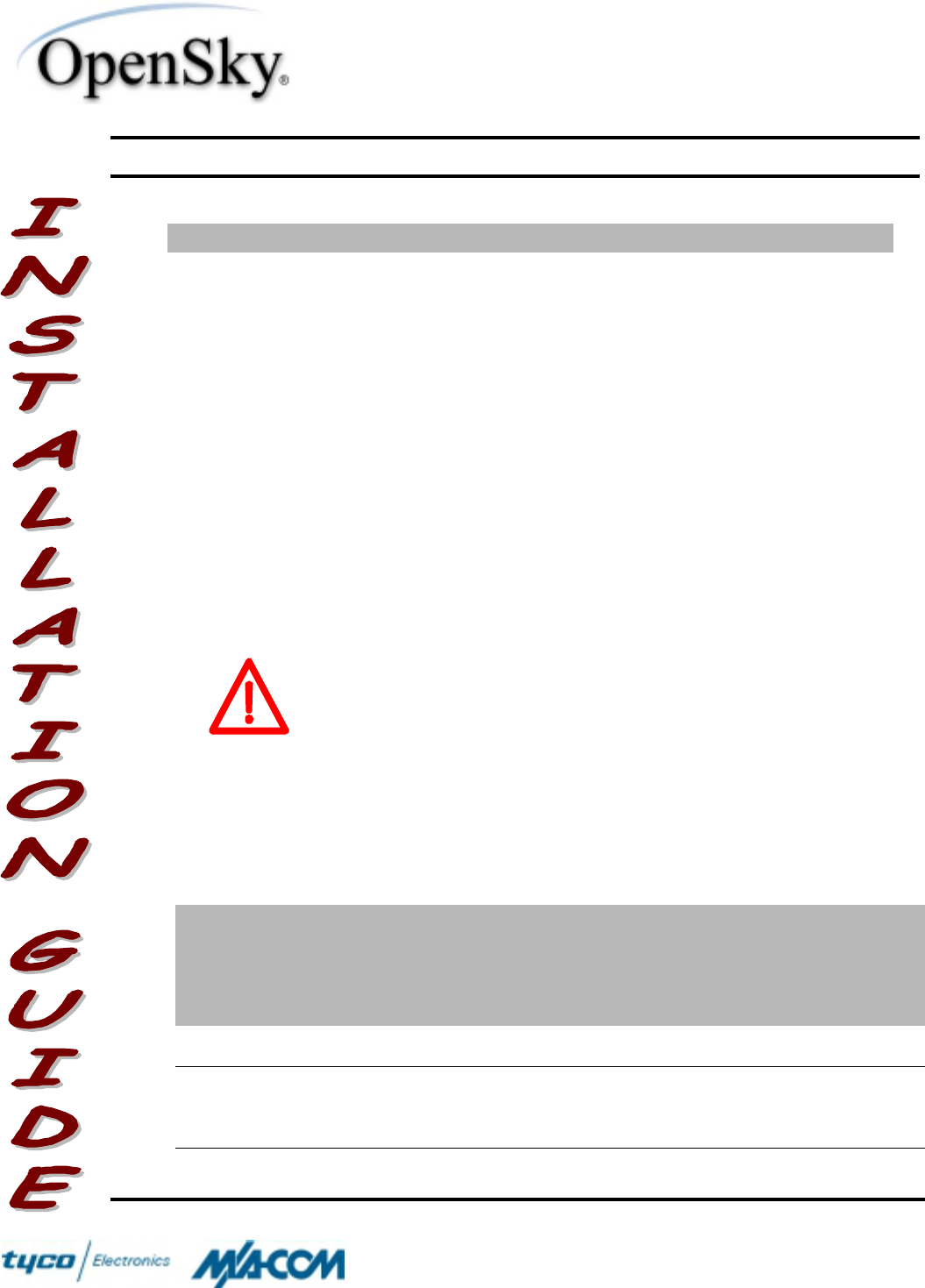
WINST-0009 Rev – WIRELESS SYSTEM BUSINESS UNIT
SUBJECT: M-803 VTAC Installation Instructions DATE: February 19, 2002
Page 13 of 19
COPYRIGHT ©2002 Printed in U.S.A.
M/A-COM
1011 Pawtucket Boulevard
Lowell, MA 01853
1-877-OPENSKY
(1-877-673-6759)
1-877-OPENSKY
IMPORTANT
Test Equipment Comments
Coaxial Cable Jumper Cable with Mini-UHF male connector on one
end and N-Series male connector on the other
end, approximately three feet in length
(Pasternack Enterprises PE3282-36 or
equivalent).
N-Series to Mini-UHF Adapter N-Series male to Mini-UHF female (Pasternack
Enterprises PE9064 or equivalent).
Dummy Load ♦ RF terminator rated at 50 ohms resistance
and greater than 50 watts power, with N-
Series male connector (Pasternack
Enterprises PE6106 or equivalent).
Antenna ♦ See the following section.
Antenna Mounting Configurations
This radio has been tested and complies with the FCC RF
exposure limits for Uncontrolled Exposure (General Population)
and Occupational Exposure. To assure optimal radio performance
and that human exposure to RF electromagnetic energy is within
the guidelines, transmit only when people are at least the
minimum safe distance away from a properly installed, externally
mounted antenna.
The antennas listed in Table II have all been approved for use with the V-TAC. Table
III lists the minimum safe distances for approved antenna types.
Table III - VR-803 V-TAC Minimum Safe Distances
OpenSky®
VR-803
Rated
Power
Antenna
Gain M/A-COM Recommended
Antenna Minimum
Distance from
Transmitting
Antenna for
Uncontrolled
Exposure
Minimum
Distance from
Transmitting
Antenna for
Controlled
Exposure
45 dBm
(max) 0 dB Maxrad #Z322 Unity Gain,
¼-Wave, Rooftop 69 cm (27 in.) 31 cm (12 in.)
45 dBm
(max) 3 dB Ant. Specialists
#ASPA1860M 3dB, Rooftop;
#ASPA915 3dB, Elevated-
Feed, Various Mounts
98 cm (39 in.) 43 cm (17 in.)

WINST-0009 Rev – WIRELESS SYSTEM BUSINESS UNIT
SUBJECT: M-803 VTAC Installation Instructions DATE: February 19, 2002
Page 14 of 19
COPYRIGHT ©2002 Printed in U.S.A.
M/A-COM
1011 Pawtucket Boulevard
Lowell, MA 01853
1-877-OPENSKY
(1-877-673-6759)
1-877-OPENSKY
The M-803 may be mounted in a wide range of vehicles with varying, non-standard
physical dimensions, so selection of an antenna and its location is not trivial. Only
install antennas where a minimum safe distance (MSD) can be maintained in a
measured, visual line of sight from the antenna location to any location where a person
may be located under normal operating conditions. Using Table II as a guide for
determining the best possible mounting configuration in order to reduce human
exposure, there are three possible locations on a vehicle where the antenna can be
mounted, described as follows:
Rooftop Center The center of the roof of a vehicle is the optimal location for the
rooftop antenna. The mounting area under the antenna must be a flat, metallized
ground plane, and it must be located directly in the center of the roof. If other
obstructions, such as a light bar or another antenna, prevent the antenna from being
mounted in the direct center of the roof, the antenna should be preferably mounted a
minimum of one foot away from the obstruction, but in the middle of the roof with
respect to the left and right sides of the vehicle.
Trunk-Lid Center Certain vehicles do not allow for the antenna to be placed in the
center of the roof. In this case, the next optimal location for the antenna is in the center
of the trunk lid. Again, the mounting area under the antenna must be a flat, metallized
ground plane, and it must be located directly in the center of the trunk lid. There are no
other preferable solutions for mounting this antenna if other obstructions prevent the
antenna from being mounted in the direct center of the trunk lid.
Trunk-Lip Center Some antennas have a feature that allows them to be mounted on
the lip of the trunk lid. In this case, the antenna is mounted on the top lip and in the
direct center of the trunk lid. Again, there are no other preferable solutions for
mounting this antenna if other obstructions prevent the antenna from being mounted in
the direct top center of the trunk lid.
Changing Operating Modes (Preliminary)
Operating the V-TAC is accomplished through the CH-103 Control Head. Follow the
actions below to change modes in order to test the Antenna.
Actions Notes
1. Press the UP ARROW button on
the navigation pad of the Control
Head repeatedly until the message
“MODE” appears on the unit’s
display, then press the SELECT
button.
♦ The buttons controlling the operating
parameters are on the left side of the
front of the Control Head.

WINST-0009 Rev – WIRELESS SYSTEM BUSINESS UNIT
SUBJECT: M-803 VTAC Installation Instructions DATE: February 19, 2002
Page 15 of 19
COPYRIGHT ©2002 Printed in U.S.A.
M/A-COM
1011 Pawtucket Boulevard
Lowell, MA 01853
1-877-OPENSKY
(1-877-673-6759)
1-877-OPENSKY
Actions Notes
2. Press the RIGHT ARROW button
on the navigation pad repeatedly
until the message “OCF” appears,
then hit the SELECT button.
♦ Select the desired operating mode,
where the mode is one of the following:
! “OCF”—To perform testing
! “OTP”—To operate the V-TAC for
normal voice or data
communications
3. Press the RIGHT ARROW button
once to confirm the selection, then
press the SELECT button to select
the mode.
♦ The V-TAC is now in OCF mode.
Testing into a Dummy Load
Actions Notes
1. Connect the wattmeter to the
Antenna Port of the RF Combiner
for testing according to Figure 2,
using the dummy load in place of
the antenna.
♦ The dummy load connects to the output
side of the wattmeter, in place of the
antenna cable (see Figure 2).
2. Apply power to the V-TAC through
the Control Head and switch to
OCF mode, if necessary.
♦ The V-TAC must be operating in OCF
mode in order to continue with the
testing procedure. If the Control Head
does not display “OCF” during startup
indicating that it is initializing in OCF
mode, use the procedure under
Changing Operating Modes above.
3. Position the slug to measure
forward RF power output. ♦ Rotate the slug, if necessary. The arrow
on the face of the slug must point from
the V-TAC toward the dummy load to
measure forward power.
4. Measure the RF power output from
the V-TAC. ♦ Key the microphone on the Contro Head
and note the wattmeter reading. De-key
the microphone.
5. Compare the wattmeter reading
with the target RF power output
range specified in the Notes
column, opposite.
15–21 watts
TARGET VALUE RANGE
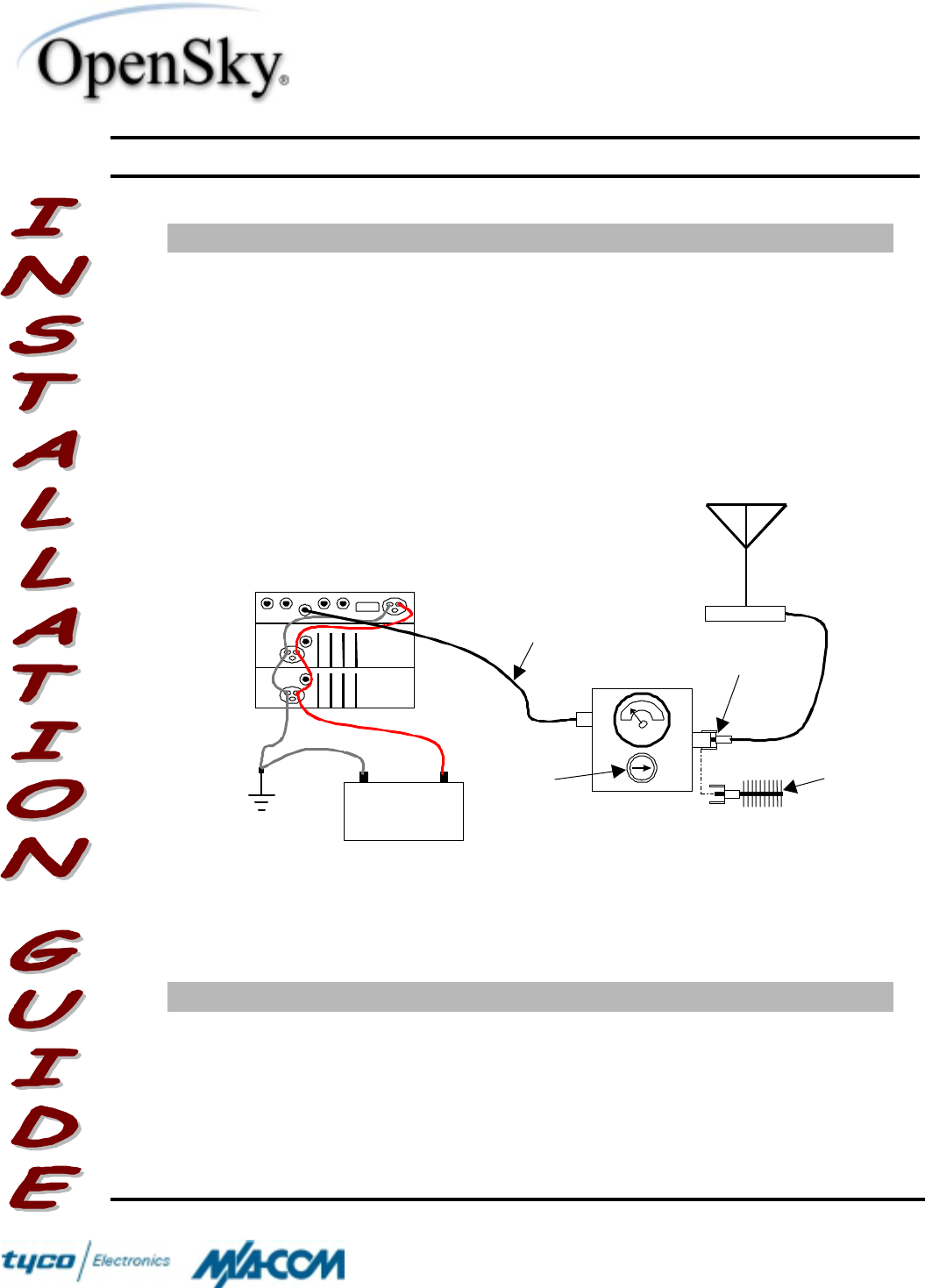
WINST-0009 Rev – WIRELESS SYSTEM BUSINESS UNIT
SUBJECT: M-803 VTAC Installation Instructions DATE: February 19, 2002
Page 16 of 19
COPYRIGHT ©2002 Printed in U.S.A.
M/A-COM
1011 Pawtucket Boulevard
Lowell, MA 01853
1-877-OPENSKY
(1-877-673-6759)
1-877-OPENSKY
Actions Notes
6. Record the wattmeter reading for
RF power output into a dummy
load, or take remedial action and
measure the output again.
♦ If the wattmeter reading is within the
target range, record the value in the
appropriate space on the data collection
sheet at the end of this guide.
♦ If the wattmeter reading is outside the
target range, recheck the power source
and all connections and measure the RF
output power again. If this fails to produce
a reading within the target range, replace
the V-TAC and repeat this procedure.
Figure 2 – Wattmeter Connection
Testing with the Antenna
Actions Notes
1. Connect the wattmeter to the V-
TAC and antenna for testing
according to Figure 2.
♦ Remove the dummy load, if necessary,
and connect the antenna lead to the
output side of the wattmeter (see
Figure 2).
2. Apply power to the V-TAC and
switch to OCF mode, if necessary. ♦ The V-TAC must be operating in OCF
mode in order to continue with the
OpenSky®
V-TAC
PWR
Wattmeter
N-Series to Mini-
UHF Adaptor
TNC to N-Series
Coaxial Jumper
Slug
(25 W, 400–
1000 MHz)
Dummy
Load
Vehicle
Battery
–+
Ground
Antenna
PWR
PWR

WINST-0009 Rev – WIRELESS SYSTEM BUSINESS UNIT
SUBJECT: M-803 VTAC Installation Instructions DATE: February 19, 2002
Page 17 of 19
COPYRIGHT ©2002 Printed in U.S.A.
M/A-COM
1011 Pawtucket Boulevard
Lowell, MA 01853
1-877-OPENSKY
(1-877-673-6759)
1-877-OPENSKY
Actions Notes
testing procedure. If the Control Head
does not display “OCF” during startup
indicating that it is initializing in OCF
mode, use the procedure under
Changing Operating Modes above.
3. Position the slug to measure
forward RF power output. ♦ Rotate the slug, if necessary. The arrow
on the face of the slug must point from
the V-TAC toward the antenna to
measure forward power.
4. Measure the forward RF power
output of the V-TAC. ♦ Key the microphone and note the
wattmeter reading. De-key the
microphone.
5. Compare the wattmeter reading
with the target RF power output
range specified in the Notes
column, opposite.
15–21 watts
TARGET VALUE RANGE
6. Record the wattmeter reading for
forward power, or take remedial
action and measure the output
again.
♦ If the wattmeter reading is within the
target range, record the value in the
appropriate space on the data collection
sheet below.
♦ If the wattmeter reading is outside the
target range, verify that the operating
voltage of the V-TAC is within the
specified range, recheck all connections,
and measure the forward power again. If
this fails to produce a reading within the
target range, check all cabling and
connections, and repeat the testing
procedure to this point. In the event the
wattmeter reading still falls outside the
target range, replace the antenna, make
sure all connections are seated firmly,
and repeat the testing procedure.
7. Position the slug to measure
reverse, or reflected, RF power. ♦ Rotate the slug. The arrow on the face of
the slug must point from the antenna
toward the V-TAC to measure reverse, or
reflected, power.
8. Measure the reverse, or reflected,
RF power. ♦ Key the microphone and note the
wattmeter reading. De-key the
microphone.

WINST-0009 Rev – WIRELESS SYSTEM BUSINESS UNIT
SUBJECT: M-803 VTAC Installation Instructions DATE: February 19, 2002
Page 18 of 19
COPYRIGHT ©2002 Printed in U.S.A.
M/A-COM
1011 Pawtucket Boulevard
Lowell, MA 01853
1-877-OPENSKY
(1-877-673-6759)
1-877-OPENSKY
Actions Notes
9. Compare the wattmeter reading
with the target RF power output
range specified in the Notes
column, opposite.
2 watts or less
TARGET VALUE RANGE
10. Record the wattmeter reading for
reverse power, or take remedial
action and measure the output
again.
♦ If the wattmeter reading is within the
target range, record the value in the
appropriate space on the data collection
sheet at the end of this guide.
♦ If the wattmeter reading is outside the
target range, make sure the antenna
installed is consistent with the specified
frequency range of the V-TAC. Recheck
all antenna connections, and measure
the reverse power again. If this fails to
produce a reading within the target
range, replace the antenna and repeat
the entire testing procedure.
♦ Any value exceeding the maximum
allowable reflected power value will result
in a diminished RF output signal*.
11. Return the V-TAC to OTP mode
for normal communications. ♦ Use the procedure under Changing
Operating Modes above. The V-TAC is
now ready for normal communications.
* The standard measure for comparing forward and reflected power is the Voltage Standing Wave Ratio (VSWR). Use the
values recorded for the installed unit’s forward and reflected power to compute the VSWR, if desired, using the following
formula:
FR PPVSWR
+= 1, where
RP
= reverse power and
FP
= forward power. This value is expressed as a ratio to
the ideal value of 1, for instance, 1.2:1.

WINST-0009 Rev – WIRELESS SYSTEM BUSINESS UNIT
SUBJECT: M-803 VTAC Installation Instructions DATE: February 19, 2002
Page 19 of 19
1-877-OPENSKY
Copyright © 2002 M/A-COM. All rights reserved. No part of this publication may be reproduced, transmitted,
transcribed, stored in a retrieval system, or translated into any language, in any form or by any means,
electronic, mechanical, photocopying, recording, or otherwise, without prior written permission from
M/A-COM. The information furnished herein is believed to be accurate and reliable. However, no
responsibility is assumed by M/A-COM for its use, or for any infringements of patents or other rights of third
parties resulting from its use. All trademarks are the property of their respective owners.
Enter the information requested on this data collection sheet. Clip this form and file it as a permanent record of
the tested performance of the installed V-TAC.
Clip " Here
F
orward Power With
Antenna
watts
R
eflected Power
With Antenna
watts
P
ower Into a Dummy
Load
watts
Company Performing Installation Technician Performing Test
D
ate of Test
(mm/dd/yyyy)
MRU
Serial Number Antenna Make and Model
VRB
Serial Number RF Combiner
Serial Number